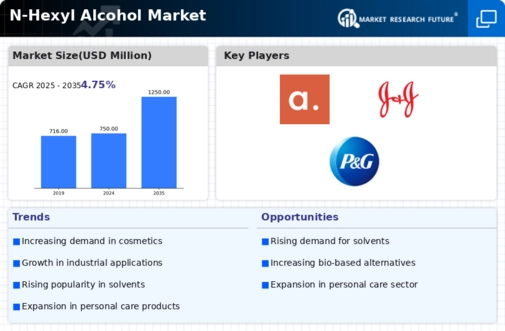Top Industry Leaders in the N-Hexyl Alcohol Market

N-hexyl alcohol, also known as hexanol or caproyl alcohol, might not be a household name, but its applications are ubiquitous, touching various industries from pharmaceuticals to fragrances.This dynamic landscape is characterized by a mix of established players and innovative newcomers, all vying for a slice of the lucrative pie.
Strategies Adopted by Market Leaders:
-
Product Differentiation: Players are moving beyond traditional n-hexyl alcohol to offer diverse grades and derivatives catering to specific applications. BASF, for instance, offers a range of high-purity hexanols for use in pharmaceutical synthesis, while INEOS Chlor manufactures hexyl esters for use in plasticizers and lubricants. -
Vertical Integration: Leading companies are integrating forward and backward, gaining control over raw materials and distribution channels. Sasol Limited, a South African petrochemical giant, owns both n-hexyl alcohol production facilities and downstream businesses in chemicals and plastics. -
Sustainability Focus: The growing emphasis on eco-friendly practices is prompting manufacturers to develop bio-based n-hexyl alcohol alternatives. Ecogreen Oleochemicals in Singapore is a pioneer in this area, producing n-hexyl alcohol from coconut oil, a renewable resource. -
Geographic Expansion: Companies are actively expanding into emerging markets like Asia-Pacific and Latin America, capitalizing on their fast-growing demand for n-hexyl alcohol. Penta Manufacturer, a US-based company, recently established a production facility in China to cater to the increasing demand in the region.
Factors Influencing Market Share:
-
End-use Industry Growth: The growth of key end-use industries like pharmaceuticals, personal care, and coatings directly impacts the demand for n-hexyl alcohol. The rising middle class in developing economies and increasing healthcare expenditure are expected to boost the market in the coming years. -
Regional Trends: The Asia-Pacific region is the fastest-growing market for n-hexyl alcohol, driven by rapid industrialization and urbanization. Europe and North America are still significant markets, but face challenges from stricter environmental regulations and mature industries. -
Raw Material Prices and Availability: N-hexyl alcohol is primarily derived from crude oil and natural oils. Fluctuations in crude oil prices and the availability of natural resources can significantly impact the cost and production of n-hexyl alcohol, affecting market dynamics. -
Regulations and Environmental Concerns: Stringent regulations on VOC emissions and hazardous chemicals are encouraging the development and adoption of safer and more sustainable n-hexyl alcohol alternatives. The European Union's REACH regulation, for example, has restricted the use of certain n-hexyl alcohol derivatives.
Key Players:
Sasol Limited (South Africa), Alfa Aesar (US), the Good Scents Company (US), Merck KGaA (Germany), Bharat Jyoti Impex (India), Penta Manufacturer (US), Sisco Research Laboratories Pvt. Ltd. (India), Ecogreen Oleochemicals (Singapore), and Zhejiang NHU Company Ltd, NHU (China).
Recent Developments:
December 2023: Sisco Research Laboratories, an Indian manufacturer, invests in research and development of a novel catalyst technology to improve the efficiency and sustainability of n-hexyl alcohol production.
October 2023: The Good Scents Company, a US-based fragrance manufacturer, launches a new line of sustainable fragrances for personal care products that utilize bio-based n-hexyl alcohol.
In March 2022 Phillips 66 announced that they had merged with Phillips 66 Partners, making Phillips 66 own all limited partnership interests in PSXP not yet bought by it or any of its affiliates.
Adding on April 2021, KLK OLEO now expanded their n-hexyl alcohol producing factories because personal care industries were also increasing along with lubricant and plasticizer markets. On top of enhancing future growth; KLK OLEO can be closer to her customers.
Further, in September 2022, KH Chemicals launched new pharmaceutical-grade n-hexyl alcohols used in the medicine-making process, such as active pharmaceutical ingredients (API). It can also be directly used as a pure pharmaceutical formulation, having few impurities due to better pH values. Therefore, mostly, it’s high-quality pH. However, this API fits only unadulterated USPs where impurity levels should always remain at their least possible limits, hence drugs/APIs, among others, due to this API covering entire drug dosage forms.









